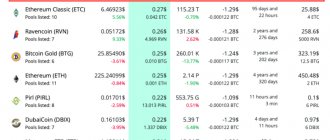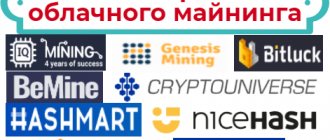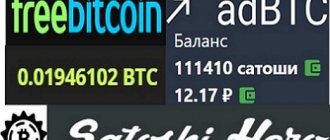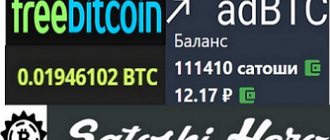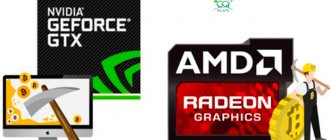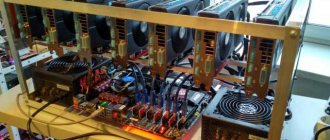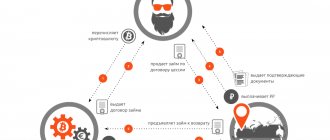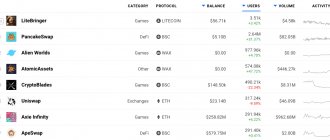Hello dear readers. The author of the blog, Ruslan Miftakhov, writes as always, and in this article I want to discuss such a phenomenon as farm mining, which is currently most relevant in the West and in the countries of Southeast Asia, especially in China.
And only recently they started mining in Russia. Many of you have probably heard about such concepts as cryptocurrency, mining on a farm, and Bitcoin, which are gaining popularity on the Internet. What it is and how to make money from it, we’ll talk about it in this article.
Where it all started
In 2008, a person or group of people under the pseudonym Satoshi Nakamoto published a file describing the protocol and operating principle of a peer-to-peer payment system. According to Satoshi, development began in 2007. In 2009, he completed the development of the protocol and published the client program code. The Bitcoin network was launched.
Further development is organized and coordinated by the development community, and any significant changes to the protocol must be accepted by the majority of mining pool owners.
The first exchange of bitcoins for real goods took place in May 2010 - American Laszlo Hanecz received two pizzas for 10,000 bitcoins!
Now 10,000 bitcoins are worth $25,000,000 or 1,500,000,000 (1.5 billion) rubles!
More recently, in 2016, they told me that Bitcoin was nonsense and would be of no use, and this despite the fact that at that time it already cost about $400. The initial price in 2009 was generally in cents))) Now it costs $2,500. I think that those who did not believe in him became much smaller. Well, those who previously bought in cents or even for $100-200 or more remained in a good plus.
In the screenshot you see the growth dynamics of Bitcoin
Personally, I didn’t buy it myself at the time and didn’t really believe in it, although I could have bought a fairly decent amount, because I’ve been in the subject for a long time. That is, back in 2015 I could have bought bitcoins for about $230. But he didn’t do this, as they say - if he had known where he fell, he would have laid out straws. In general, I’m not very worried about this, but somewhere in the depths there is a worm sitting and gnawing - I could have, but I didn’t)))
Comparison of the efficiency of cloud and conventional mining
Websites for making money from cloud mining have calculators that offer estimates of the expected return on investment. The estimate is quite inaccurate (the cryptocurrency rate is not static), but it is suitable for comparison with conventional mining.
First, let's evaluate the performance of a regular farm of 6 video cards; let's assume a miner is mining Ethereum.
Farm characteristics:
- 6 x RX580;
- the hashrate of one is 30 MH/s;
- the consumption of one video card is 135 W, the farm consumes about 850 W per hour;
- cost – 13.5 thousand rubles for 1 video card;
- let's add the cost of the power supply, motherboard, frame for the farm and come up with an amount of 90-95 thousand rubles;
- cost of electricity - let's take the average price of 5 rubles. per 1 kWh or $0.076923 per 1 kWh.
For a year at the current rate, earnings will be $593.55, provided that the value of Ethereum remains the same. In IQ Mining, for approximately the same starting conditions, they promise a slightly larger profit. Payouts are expected to be $725 per year, or 22% more than a homemade farm.
The reason for this difference is the reduced cost of electricity; perhaps the equipment was purchased at wholesale prices. Each company determines its own pricing policy.
At the same time, you will have to pay $1,125 for a 2-year tariff under these conditions, or around 72-74 thousand rubles. If the current value of Ethereum is maintained, earnings will be at least $1,450 in 2 years, and the return on investment will be $325. Cloud mining will give you $325 for 2 years, but then you will have to pay again for the rental of computing power. The return on investment in our example is 1.55 years.
With your own farm the picture is different. We spent around $1,390; with an annual return of $593.55, it will pay off in 2.34 years. But keep in mind that the equipment remains your property; it can be sold on the secondary market and offset part of the costs. On the other hand, there is a possibility that the farm will fail, which will push back the payback point.
Much depends on the crypto rate and the cost of electricity. Mining can even become unprofitable if the rate of Bitcoin and altcoins drops significantly.
Does it make sense to buy Bitcoin now?
I think there is, but only in terms of the long term. At the moment, there will most likely be a downward correction, because everyone has pounced on it. And the correction will continue until the majority of players simply lose their money due to the fact that they will thoughtlessly buy and sell. But friends, these are my personal thoughts and I could be wrong)) Cryptocurrencies can both rise and fall. Although Bitcoin has not fallen much in its entire history, and since it is limited in quantity, there will always be growth.
In general, of course, cryptocurrencies are an undeniable trend and you should definitely pay attention to them. Many states already recognize cryptocurrencies and even in Russia they are talking about it, but rather quietly, one might say in a whisper. You yourself understand that not everyone should know about highly profitable projects.
I think you have already heard about cryptocurrency mining farms. But this, one might say, is getting money out of thin air! We are at the very beginning of the development of crypto money, which may soon completely absorb paper money in principle. What does the farm do? The farm works according to a special algorithm and extracts cryptocurrency to your account in the form of the coin that you mine. There is a huge community of miners who do this.
In China, there are huge farms (often called mines) for mining Bitcoin, Ethereum and other coins. The income of such a huge mine is about $1,500,000 a month!
Here is a video about such mines so that you understand the principle of operation
Money is made practically out of thin air! The computer mines moments, and coins grow in price. Taking into account capitalization and rate growth, this is generally a sky-high profit!
Bitcoin is great, but not everyone has the money to buy it at that price right now. But as you know, there are a lot of cryptocurrencies that are growing quite quickly and are currently worth much less. The cost of different currencies ranges from a few hundredths of a cent to $1-100 and more. That is, you can buy a currency for 10 cents and in a year make a profit of 100 times the amount.
You need to understand that this market is quite complex and there is no point in buying everything, otherwise you can lose everything. Only those cryptocurrencies that are backed by corporations and a large injection of capital will grow. Overall, this is a complex process that requires study. I am currently following trends and as I study, I will share my experiences with you.
Strengths and weaknesses of crypto mining in the cloud
Cloud mining of cryptocurrency has disadvantages, for some they can be critical.
| Advantages | Flaws |
| No need to spend money on equipment or look for a place for a farm | There are scammers, little leverage |
| The company solves the issue of energy supply and uninterrupted operation | Mining becomes more expensive, the company includes its risks in the rental price |
| No need to configure software or look for profitable coins | You are not in control of the process |
Don’t expect miracles - by investing $100 you will not earn $1,000,000 in six months or a year, unless the cryptocurrency rate skyrockets tenfold. The standard principle applies - if you want big money, you will have to invest a substantial amount.
Cryptocurrency Ethereum
For example, let's take Ethereum, which has also shown serious growth and is currently undergoing a downward correction, which may soon end and there will be growth again.
Ethereum is a platform for creating decentralized online services based on the blockchain, working on the basis of smart contracts. Implemented as a single decentralized virtual machine. Proposed by the founder of Bitcoin Magazine, Vitalik Buterin at the end of 2013, the network was launched on July 30, 2015.
Being an open source platform, Ethereum greatly simplifies the implementation of blockchain technology, which explains the interest from not only new startups, but also major software developers such as Microsoft, IBM and Acronis. Financial companies, including Sberbank of Russia, are also showing noticeable interest in the platform.
Let's look at the growth of the Ethereum coin.
Let's do some math, because numbers always show everything clearly, clearly and simply. Moreover, we will not run too far back, but take 6 months of this year 2022 as an example.
The price of Ethereum on January 1, 2022 was $8.17.
The cost of Ethereum on June 1, 2022 was $220
In 6 months, this currency has grown 27 times!
Simple arithmetic, if you bought $1,000 worth of Ethereum in January, you would now sell it for $27,000! Please note that we are not talking to you about peak prices. Ethereum rose to almost $400. We are talking about real numbers taking into account exchange rate volatility.
Tell me, who else will give you such profitability? I think that now you understand that cryptocurrencies are the future.
Difficulties of trading
However, this method is also not as simple as it seems. Firstly, the buying and selling of cryptocurrency takes place on a cryptocurrency exchange. You need to understand how the exchange works, its functionality, and capabilities. These are fairly easy to figure out.
The problem is different. The essence of trading is a constant presence in the market. Using all available tools to realize profits. In essence, trading can be considered a full-time job in which you need to be involved 24⁄7. Just like in any job, in order to make big profits and not constant losses, you need to be a professional in your field. You need to have very good knowledge in analyzing the cryptocurrency market, have an analytical mind and perfectly know everything related to cryptocurrencies. Otherwise, you simply won’t know which of the thousands of cryptocurrencies you need to buy right now so that it grows in the near future. And also when exactly it needs to be sold in order to make a profit and not incur losses.
How does it all work?
To understand cryptocurrency, you need to start by understanding what a blockchain (or block chain, if translated from English) is. What blocks are we talking about? Let's take a step on the first step of our ladder:
First
We all know what a transaction is - these are actions aimed at changing the status of the civil rights and obligations of the persons taking part in it, i.e. on their occurrence, transfer or termination [Civil Code of the Russian Federation, Art. 153]. Transactions occur every minute, even every second, and are necessarily recorded in some register. Now let’s imagine that a certain group of transactions is combined into blocks that store information about them, and this information cannot be subject to any changes. Let's look at this with an example.
Anton decided to give Nina one of his clay pots kept in the museum. At the same time, the pot is, of course, an asset (property, securities, information, gold, real estate rights, just money). Anton transfers ownership rights to Nina, i.e. makes a transaction, also called a transaction. It may also be that Anton did not give his clay pot to Nina, left it in the museum collection, but transferred ownership rights to the girl. In this case, the transaction is also considered completed and is included in the register.
Second
“Gets on the register”, i.e. becomes visible to all museums storing clay pots. In fact, they all keep a register of transactions made with clay pots, so if Anton transfers ownership to Nina, the entire network of museums will know about it. This is called transaction accounting.
Imagine that each registry stores the same information about asset owners. Any operation automatically updates the distributed registry of all servers (in this case, museums) interconnected by a network. Therefore, even if one of the blockchain participants turns off the computer and does not save information about completed transactions, the consensus procedure will allow you to restore what was missed by simply copying it from another server.
Anton may not be the only one transacting clay pots. In fact, there are a lot of them, so they are combined into blocks connected into a chain. Their main properties are consistency and irrevocability. The information entered in the block cannot be changed in any way.
Anton, having changed his mind about giving Nina a clay pot after transferring ownership, will not be able to change the entry in the block, because it is already preserved in all museums. But who creates these same blocks, and generally makes sure that transactions are carried out according to the rules?
Third
Miners (from the English miner - “resource miner, miner”) are the main characters of the blockchain. In our example, these are some kind of museum guards who ensure that the rights to clay pots and other objects of art are transferred clearly, honestly and without falsification.
Miners mainly perform three functions:
- store copies of the blockchain, thereby protecting information from falsification;
- confirm transactions;
- check transactions registered by colleagues - other miners.
Miners need to have special equipment of sufficient power with appropriate software. The greater the number of miners in the network, the more reliable it is, because the less likely it is that counterfeit transactions will occur.
However, a reasonable question arises: are they doing this on a charitable basis? Of course not. And the miner's reward consists of two components:
- transaction commission;
- reward from the network (the same cryptocurrency mining).
If the first point is more clear (by the way, it should be noted that commissions are usually not so high, because there are many miners and they all compete with each other; accordingly, according to market rules, the price falls), then the second needs to be clarified. If the network exists autonomously and is not regulated by anyone (in fact, it operates decentralized, without any intermediaries), then who sends the reward to the miners? Actually, the system itself generates a new amount of cryptocurrency - it becomes a reward for new participants who receive a certain amount of it.
Thus, the cryptocurrency appears with each new block from the chain (blockchain) until its quantity reaches the limit value and miners receive only commissions from transactions. But the question remains open: how exactly among a large number of miners are those who add a new block to the chain selected?
Fourth
To answer the last question, the system has provided special tasks. The more powerful a miner's hardware is, the higher the likelihood that he will solve the equation, share the answer with all other miners, and add a new block. By the way, some miners sometimes solve these problems manually for fun, and they do not always turn out to be overwhelmingly complex [M. Ablov, 2015].
By the way, if you also want to have fun and at the same time improve your creative abilities, we advise you to take our online program “TRIZ in Practice”, within the framework of which you will interactively solve difficult inventive problems for 4 weeks. Of course, the result of solving problems will not be the extraction of cryptocurrency, but the program will largely allow you to improve your cognitive abilities, which can be successfully applied to solving mining problems.
Returning to our Anton, imagine that he decides to create a very intricate problem (essentially a brute-force equation) for new aspiring museums that want to start keeping records of transactions. The one who does it better will be able to create a new block of Anton’s operations (and not only his) and earn cryptocurrency.
In addition, each miner is assigned an electronic wallet, protected by encryption as one of the cryptographic methods. Thanks to encryption, information about the miner's assets and transactions remains confidential, complete and correct [Financial Culture, 2020].
Fifth
Cryptography is the science of methods for classifying information, authenticating it and encrypting it. Cryptocurrency has this name, i.e. includes the root “crypt”, precisely because all operations occur strictly encrypted, using cryptographic keys, which are a sequence of certain characters. This allows you to protect the blockchain from hacking and protect financial transactions from cyber attacks, which, alas, occur quite often.
Unfortunately, practice still knows cases where cryptocurrency startups, seemingly protected by two-factor authentication (entering a username, as well as a code from an SMS or some kind of password), were hacked. Thus, in 2022, Investopedia (a platform for training and tracking financial processes on various exchanges) recorded major attacks on transactions of Coincheck and BitGrail, the losses from which amounted to $534 million and $195 million, respectively [Kaspersky Lab]. Therefore, of course, cryptographic encryption is not a panacea for all attackers.
However, it should be recognized that the cryptocurrency mechanism is in many ways superior to operations with ordinary fiduciary money, because he still:
- firstly, it is decentralized and not directly subject to political processes;
- secondly, it carries transparent rules for issue and use;
- thirdly, it is also a payment system, which eliminates the need for the intermediation of Visa or MasterCard;
- fourthly, it serves as a full-fledged means of exchange and payment, but only in those countries where it is officially permitted.
This is how the cryptocurrency generation mechanism works. Let's now look more specifically at what cryptocurrencies exist, where to buy them and at what price.
What affects profitability?
Mining is the process of ensuring the functionality of the network of some cryptocurrencies, which requires significant resources in the form of computing power.
Miners are users who ensure the passage of transactions, decentralization of the network and its protection from unauthorized access and changes. They receive a reward in cryptocurrency for the operation of their equipment.
The profit of miners depends on 3 components:
- The number of coins received. This important indicator of a miner’s earnings is based on the power of the equipment, the complexity of mining and the magnitude of the reward.
- Cryptocurrency prices. Cryptocurrency prices are determined by the market. And miners cannot influence them in any way. Unless, of course, the miner of digital assets is the owner of a large number of coins who wished to sell them at once.
- Cost of equipment and related expenses (electricity costs, equipment maintenance, Internet fees, etc.).
It is possible to determine how profitable mining is only in the short term: today, this week, this month. The longer the analysis period, the more difficult it is to make reliable profitability forecasts. This is due to the factors on which the income of cryptocurrency miners depends. They are not constant and change dynamically over time.
